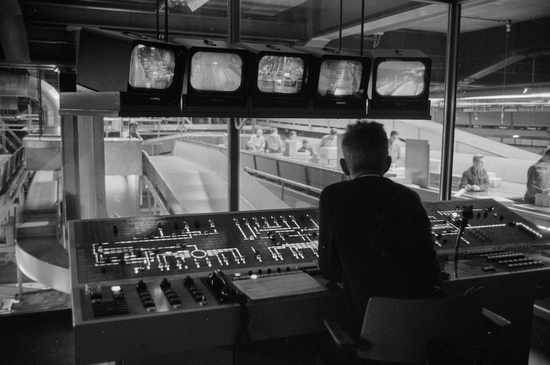Operative TV: Audiovisual Closed-Circuits from the Military to the Classroom, 1930s-1990s
From video surveillance to online teaching, from drone warfare, highway management to telemedicine: closed-circuit images take up multiple spaces today. Despite being quotidian, their history remains largely unknown. The SNF-PRIMA project Operative TV pursues the goal to fill this gap by providing a study of audiovisual closed-circuits in the longue durée. It scrutinizes the closed-circuits’ diversity between the 1930s and the 1990s and develops case studies from the USA, France, the UK, Germany, and Switzerland – countries crucial for the development of closed-circuits and providing access to resources for writing the history of a medium whose images were conceived as instruments rather than representations.
Distributed under Industrial Television and CCTV (for closed-circuit television), the systems were developed in Europe and the USA mainly by enterprises active in televisual R&D (i.e., RCA, Grundig, and many more). In their most basic organization, they connected a camera with a monitor by cable; more sophisticated designs allowed for the video recording of content or bi-directional conversation. While CCTV today stands as a synonym of the surveillance camera, its historical applications were at least as heterogeneous as contemporary closed-circuits and used on factory floors and in nuclear plants, in hospitals and schools. However, Operative TV also emphasizes televisual practices beyond the surveillance framework and the closed-circuit’s embeddedness in multiple institutional spaces. Drawing upon multinational archival research, Operative TV examines two main hypotheses. First, itposits that the analysis of television in industrial, educational, and military contexts cannot be based on habitual analytical categories such as texts or spectators. Instead, the study of CCTV necessitates a methodological shift towards an understanding of audiovisual production as a chain of operations that allows analyzing the entanglement of human and non-human actors. CCTV’s usefulness indeed was contingent on the interplay of heterogeneous elements including operators, screens, infrastructures, and images: their interdependence, rather than the isolated components, should form the core of a historical enquiry. Second, Operative TV argues that the history of CCTV, an analog-electronic technology, nourishes a media archaeology of the digital. CCTV emerged at the same moment as digital computers; it coexisted and sometimes converged with digital machines. Before the computer definitively took over factory and office floors, television was used as a tool for operations ranging from targeting to instructing: analyzing CCTV’s alleged universality allows to better understand the emergence of our digital society. To discuss these two hypotheses, the project draws upon recent media theory, and looks more specifically at four operations performed by CCTV. In addition to the operation of surveilling, targeting was a central – and first – function of closed-circuits from the 1930s on; automating the workplace and instructing students were other tasks performed by closed-circuits in the postwar years. Sustained by complex human-machines ecologies, these operations would rapidly be executed by digital computers: before their digitization, they were the realm of analog TV.
Team
- Dr. Anne-Katrin Weber, Projektleitung
- Dr. des. Lisa Cronjäger, wissenschaftliche Mitarbeiterin
- Dr. Marie Sandoz, Post-doc
- Sébastien Scheiwiller, Doktorand
Quick Links
Social Media

